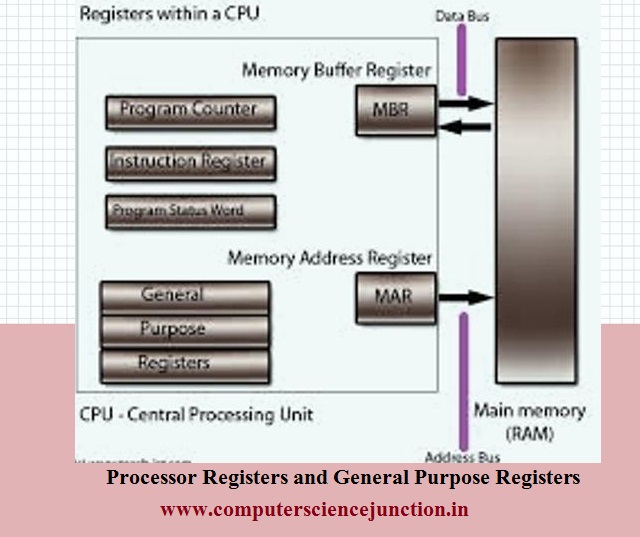What Are The Different Types Of Registers
Unlike types of registers in estimator architecture of a modern calculator system are available now a days. These registers play a vital function in storing a minor amount of data.
Questions based on registers and types of registers are generally asked in interviews and practical examination viva voce. So computer science students should have knowledge about the basic concepts of registers.
This tutorial is particularly prepared for students to provide them a better agreement of the registers. In this tutorial, students will larn about register introduction and different types of registers.
Likewise Read – Substring in Java Example and Program
Table of Contents
- one Ofttimes Asked Questions
- 2 What is a Computer Register?
- 3 Types of Registers in Figurer Architecture
- iii.ane 1 – Internal Registers or Processor Registers
- iii.1.1 Fetch
- iii.1.ii Decode
- iii.1.3 Execute
- 3.one.iv ane. Program Counter Annals
- 3.i.v 2. Memory Address Annals
- 3.1.vi 3. Didactics Register
- 3.1.7 4. Retentivity Buffer Register (MBR)
- 3.one.8 5. Retentivity Data Register (MDR)
- 3.ane.9 6. Accumulator
- iii.ane 1 – Internal Registers or Processor Registers
- 4 2 – User-Accessible Annals
- 5 Differences betwixt the 2 types
- 6 Applications of Registers
- 7 Conclusion and Summary
- 7.1 Share this:
- 7.2 Related
Ofttimes Asked Questions
Some frequently asked questions from types of registers are listed beneath. Past the finish of this tutorial, the pupil will able to answer the following questions
- What is a register ?
- What are registers in reckoner ?
- What are the different types of registers in computer architecture?
- What is the accumulator?
- What is Program Counter?
- Write the deviation betwixt MAR and MBR.
- What is the Index register?
- What are the different phases of instruction?
- What do you understand by addressing mode ?
- What are Opcode and Operand?
Besides Read – How to impress in an Interview ? ( Elevation 10 Ways )
What is a Computer Register?
What is register in microprocessor ? Some fourth dimension this question is asked in viva voce or iin technical interview. Allow's sympathize the registers definition.
Registers hold an important position in computer architecture. These are the temporary storage surface area in the computer, where the newly fetch data is stored.
A register is a sequential excursion . Registers are a group of flip-flops where each flip-flop stores one bit of information.
An n-bit register contains the n-flip-flops which are capable of storing information in $.25. These are responsible for storing data as an when needed.
A Registers every bit a whole has both flip-flops and Gate. Flip-flops store the $.25 of information equally and when needed while Gate is responsible for transferring the data to the register.
There are diverse types of registers available in the market containing both the flip-flops and registers. But some of the simplest and best registers commonly contain only the flip-flop.
Registers differ in the bit-operations within the computer architecture. Some of the registers are 8-scrap, 16-fleck, 32-scrap, and now nosotros have 64-bits also.
These registers differ in the operations similar fetching the instructions. A 32-bit register can fetch 32 bits of information at a time, besides information technology tin can process 32-bit of information only.
Besides Read – GSM Total Form and Architecture
Central Point 1- Register is not only used for storing the information only likewise used to accept and transfer the data rapidly.

Types of Registers in Computer Architecture
There are ii types of registers. Some registers are internally in the processor while the other one is user-attainable. These ii types of registers differ in their accessibility to computer compages.
1 – Internal Registers or Processor Registers
Equally the name suggests, these types of registers are used in the processor internally. Internal registers are also known as processor registers.
These registers are used by CPU to perform various operations or during the different phases of an educational activity such as fetch, decode, and execute. This is the function of register which belong to microprocessor.
-
Fetch
During the fetch phase, an didactics is fetched from the retentivity.
-
Decode
Once the didactics is fetched from memory later that pedagogy is decoded and so that teaching can be interpreted. In this phase, CPU finds out the performance to be performed and this operation is denoted by an opcode.
-
Execute
Once the operation is identified during the decoding phase so the arithmetics and logical unit perform that functioning and the result is stored in retention from where the result is displayed to the user.
Here the data and the instructions are fetched internally and are sent to the processor directly inside the processor.

Different types of registers in microprocessors are as follow –
ane. Program Counter Register
Program Counter Register holds the address of the next instruction to be fetched. Educational activity is fetched from the address specified past the Program Counter (PC).
Once the teaching is fetched then the value with each functioning PC increments its value.
2. Memory Accost Annals
The address specified by the PC offset goes to another annals known as retentiveness address register. CPU finds this accost from MAR to read the instruction or information from memory.
If CPU wants to write some data in memory then at which address this data volition be written then this address is also specified by MAR.
It ways MAR merely stores the address from which CPU needs to fetch the instruction or information and also store the address where the data will exist store in memory.
Also Read – NIST Cloud Computing Reference Compages
three. Instruction Annals
Once the instruction is fetched from memory and then fetched educational activity is stored in Instruction Register, Decoder is continued with this instruction register and decode the fetched pedagogy.
4. Retention Buffer Register (MBR)
This register is used for buffering of the retentivity and then that instruction is not halted abruptly to the processor
5. Memory Data Register (MDR)
When an pedagogy is decoded and then we get the information most opcode, mode, and address field. This address field provides the data either directly or indirectly about the address of the operand.
When the operand address is found out the operand is fetched from that accost and this operand is stored in a register known as memory information register.
6. Accumulator
An accumulator is a blazon of registers that are used by CPU. This accumulator acts as a temporary storage location which holds an intermediate value in mathematical and logical calculations.
2 – User-Accessible Register
The second type of registers is important for computer architecture in enabling the accessibility to the instructions and fetch signals.
These registers are likewise known as full general-purpose registers. It has a larger size as compared to the internal registers, hence these registers stores and perform operations larger than the internal registers.
Despite being larger in size in terms of retentiveness, these registers take a longer time than the taken commonly by the internal registers in performing its operation.
These registers include the Data register, responsible for temporarily storing the information being transmitted from one peripheral device to another.
As well Read – Divergence Betwixt MongoDB and SQL Based Database
An opcode represents the operation to exist perform executed by the CPU. In Estimator Architecture opcode is denoted in assembly language in mnemonic form. This opcode is as well known equally a control.
For example, consider the following instruction
ADD R1, R2
The opcode is the ADD which represents that we add-on of values stored in register R1 and register R2 should exist performed.
The operandis the data on which the operation is going to be executed by the CPU. Aa in the above instruction Operands are the values stored in annals R1 and register R2.
The operand may be data value stored in retention at some accost.
Differences betwixt the two types
Both the types of registers the Internal register and the User-accessible register perform the same operation of fetching the instruction signals to the processor and holding the primary memory for a small fourth dimension.
They differ in the size, as an internal register has a larger size than that of the user-accessible register. Also, these two registers differ in terms of the fourth dimension of execution, as the user-accessible register is readily available for fetching instructions it takes a shorter time than that of the internal registers.
Applications of Registers
Registers are responsible for the fetching of the instructions from the plan to the processor, thereby running the whole computer architecture.
They provide the memory space for the instructions to be stored at the earliest time possible.
These registers increment the efficiency of the different operations like pipelining and hence provide speed to the operations in the program in the computer architecture.
Conclusion and Summary
Nosotros have learned most the basics concepts of registers. Unlike types of registers are also discussed here in this tutorial. The application or employ of each blazon of registers is as well discussed here in this tutorial.
Important for Studen t – To Learn Computer Architecture and practice GATE(CS/IT) Exam questions click at the link given below
computer architecture tutorial
I hope this type of registers tutorial volition be helpful for computer science students.
Please provide your feedback or leave a annotate so that we tin can improve and provide yous a good quality tutorial. Students or readers of this tutorial may ask their queries related to DBMS architecture in the annotate department.
If you detect this page useful then please Like and Share the postal service on Facebook, Twitter, LinkedIn through their icons as given below.
Cheers!
What Are The Different Types Of Registers,
Source: https://www.computersciencejunction.in/2020/08/11/types-of-registers/
Posted by: damicopriout37.blogspot.com


0 Response to "What Are The Different Types Of Registers"
Post a Comment